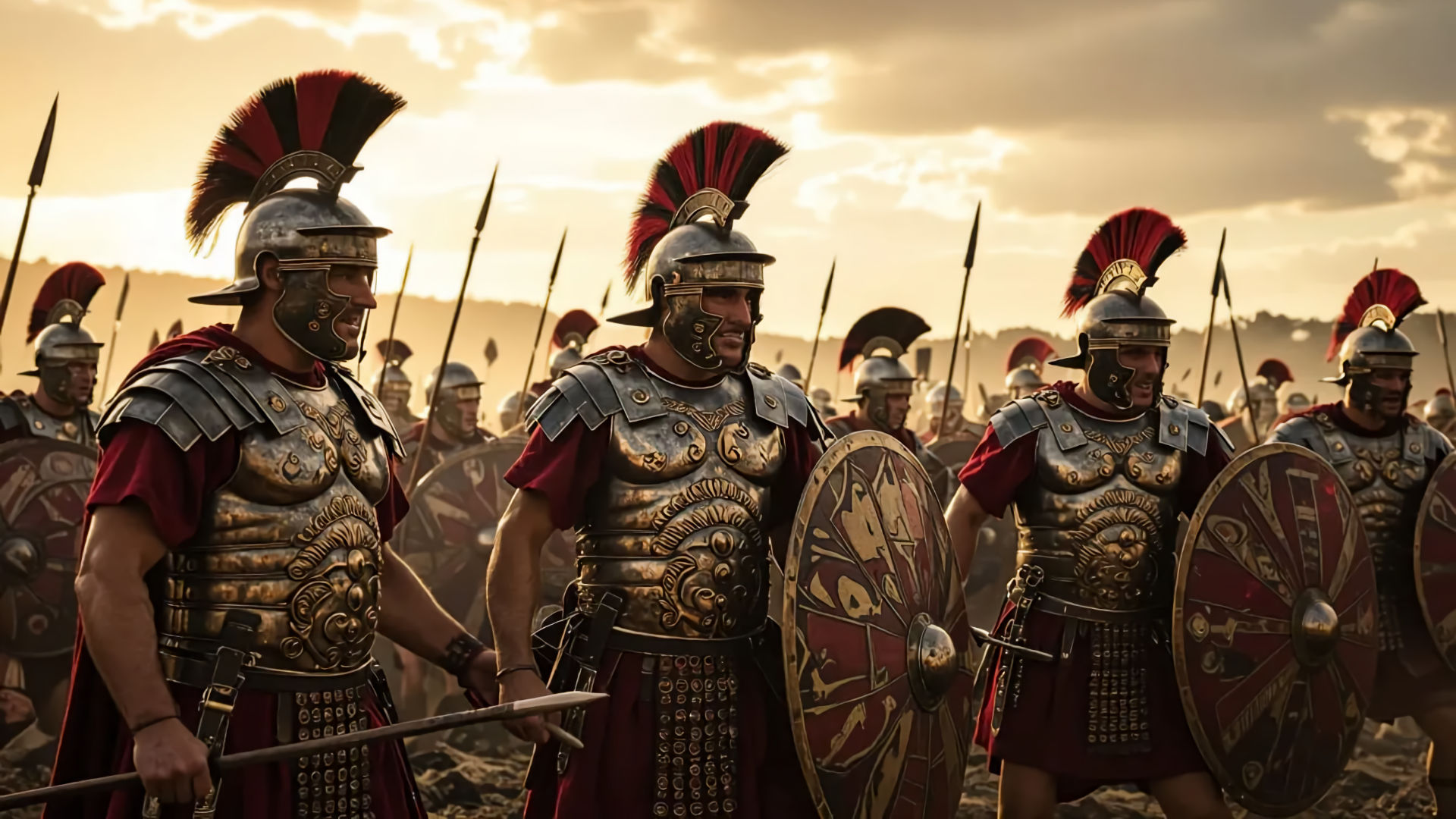Julius Caesar’s Gallic Wars
Julius Caesar’s Gallic Wars, fought between 58 and 50 BCE, marked one of the most ambitious and significant military campaigns in Roman history. The conquest of Gaul not only expanded the Roman Republic’s influence northward but also cemented Caesar’s reputation as one of history’s greatest military commanders. His campaigns against the Gallic tribes, chronicled in his own writings, Commentarii de Bello Gallico, showcased his strategic brilliance, political acumen, and the relentless discipline of Rome’s legions. The war was not merely a conflict for territorial expansion; it was a personal and political endeavour that ultimately paved the way for Caesar’s rise to absolute power.
At the outset of the Gallic Wars, Rome controlled much of the Mediterranean world but had limited authority beyond the Alps. Gaul, a vast region covering modern-day France, Belgium, and parts of Switzerland and Germany, was home to numerous fiercely independent tribes. Though they shared cultural similarities, the Gauls were divided, often engaging in intertribal conflicts. This disunity made them vulnerable to an external force with the organisation and discipline of Rome. Caesar, serving as governor of Cisalpine Gaul and Transalpine Gaul, saw an opportunity not only to expand Rome’s territory but also to bolster his political standing in Rome, where his rivals sought to undermine him.
The campaign began in 58 BCE when the Helvetii, a large Gallic tribe, attempted to migrate westward, threatening Roman territories. Caesar swiftly moved to intercept them, defeating them at the Battle of Bibracte. This early victory established Rome’s dominance in the region and demonstrated Caesar’s willingness to intervene in Gallic affairs. His intervention was framed as a defensive measure, but in reality, it provided a justification for deeper involvement in Gaul.
As the conflict progressed, Caesar encountered greater resistance. The Germanic king Ariovistus, who had established a stronghold in eastern Gaul, posed a direct challenge to Roman authority. Caesar confronted him at the Battle of Vosges, where Roman discipline and tactical superiority secured a decisive victory. With the Germanic threat eliminated, Caesar turned his attention to the remaining Gallic tribes, systematically bringing them under Roman control.
One of the defining moments of the war came in 57 BCE when Caesar launched a campaign against the Belgae, considered the most warlike of the Gauls. The Belgae, united in opposition to Rome, fielded a formidable army, but Caesar’s strategy of divide and conquer proved effective. In a series of brutal battles, the Romans crushed the Belgic coalition, with the decisive victory at the Battle of the Sabis breaking their resistance. The defeat of the Belgae further solidified Rome’s hold over northern Gaul.
Caesar’s campaigns were characterised by remarkable logistical planning, innovative siege tactics, and ruthless efficiency. His legions built roads, fortified camps, and established supply lines, ensuring they could sustain prolonged campaigns far from Rome. He also used psychological warfare, often offering clemency to tribes that surrendered while showing no mercy to those who resisted. Entire settlements were razed, and thousands of captives were enslaved, sending a clear message to other tribes that defiance would not be tolerated.
In 55 and 54 BCE, Caesar undertook expeditions beyond Gaul, crossing the Rhine into Germanic territory and even venturing into Britain. These campaigns, while not resulting in lasting conquests, demonstrated Rome’s reach and the seemingly unstoppable momentum of Caesar’s forces. The invasion of Britain, in particular, was an unprecedented move that showcased Rome’s naval capabilities and its willingness to expand into unknown lands. Though these expeditions did not lead to immediate annexation, they laid the groundwork for future Roman involvement in Britain.
Despite his successes, resistance to Roman rule in Gaul persisted. The most serious threat came in 52 BCE, when a charismatic young chieftain named Vercingetorix united the Gallic tribes in a final, desperate rebellion. Unlike previous leaders, Vercingetorix understood Roman tactics and employed scorched earth strategies, forcing Caesar’s legions to struggle for supplies. The rebellion culminated in the Siege of Alesia, where Vercingetorix and his forces made their last stand. Caesar’s response was one of his greatest military achievements. Facing a massive Gallic army both within and outside Alesia’s walls, he constructed a double line of fortifications, trapping the defenders while simultaneously keeping reinforcements at bay. After weeks of brutal fighting, the Gauls were starved into submission, and Vercingetorix surrendered. The rebellion had been crushed, securing Caesar’s ultimate victory in Gaul.
The aftermath of the Gallic Wars saw the complete incorporation of Gaul into the Roman sphere. With the tribes subdued, Rome established new provinces, introduced Roman infrastructure, and spread its culture throughout the region. The conquest brought immense wealth to Rome through plunder, taxation, and the sale of Gallic captives into slavery. More importantly, it elevated Caesar to unprecedented heights of power. His military successes made him immensely popular among the Roman people and his legions, but they also alarmed the Senate and his political rivals. Fearing his growing influence, the Senate ordered him to disband his army and return to Rome as a private citizen. Instead, Caesar crossed the Rubicon in 49 BCE, an act of defiance that led directly to the civil war and the end of the Roman Republic.
The legacy of the Gallic Wars was profound. They marked the expansion of Roman influence beyond the Alps, shaping the cultural and political development of what would become modern France. The conquest demonstrated the effectiveness of Roman military organisation and the ability of a single leader to reshape history through bold action. It also served as a turning point in Caesar’s career, transforming him from a successful general into a political force too powerful to be contained within the boundaries of the Republic.
Caesar’s own account of the wars, Commentarii de Bello Gallico, remains one of the most important historical sources on the period. Written in a clear and concise style, it not only details his military campaigns but also serves as a piece of political propaganda, justifying his actions to the Roman people and reinforcing his image as a brilliant strategist and leader. Through his victories in Gaul, Caesar secured his place in history, but he also set in motion events that would lead to the fall of the Republic and the rise of Imperial Rome. The Gallic Wars were more than just a series of military campaigns; they were a pivotal chapter in Rome’s expansion and a testament to the ambition and tactical genius of Julius Caesar. They reshaped the ancient world, bringing Gaul under Roman control and altering the course of European history forever. The battles fought, the alliances made and broken, and the ultimate triumph of Rome over the Gallic tribes ensured that Caesar’s legacy would endure for centuries.
Julius Caesar’s Gallic Wars FAQ
The Gallic Wars were a series of military campaigns led by Julius Caesar from 58 to 50 BC, where Rome conquered Gaul (modern-day France and Belgium).
The wars expanded Roman territory, increased Caesar’s power, and played a key role in the fall of the Roman Republic and the rise of the Roman Empire.
Caesar’s forces fought various Gallic tribes, including a major rebellion led by Vercingetorix, a chieftain who attempted to unite the tribes against Rome.
Rome emerged victorious, Gaul became part of the Roman world, and Caesar’s military success propelled him towards political dominance in Rome.
[this article originally appeared on 5MinuteWarfare.com on 18 June 2025]






